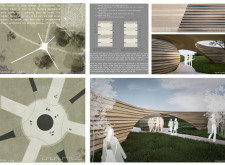5 key facts about this project
The Pavilion features a radial layout that encourages movement and accessibility, with a central gathering area surrounded by pathways that connect various facets of the space. This design not only promotes communal activities but also enhances the user experience through its spatial organization and openness to the landscape.
Unique Rammed Earth Wall and Its Significance
A key aspect of the Pavilion is the rammed earth wall, which serves multiple functions. This structural element reflects the project’s focus on sustainability and environmental harmony by using local earth materials. The wall is designed to undergo a gradual transformation due to erosion, showcasing how architectural elements can be responsive to their environment. This approach differentiates the Pavilion from conventional buildings by integrating the aging process into its design, allowing the structure to correlate with its temporal theme.
The façade's initial appearance emphasizes smooth, horizontal lines that will evolve over time, adding to the overall narrative of the project. The erosion checks anticipated in this design provide an opportunity for visual and tactile engagement, reinforcing the concept of time and change for all visitors.
Sustainable Architecture and Community Engagement
Another notable feature is the Pavilion's commitment to sustainability. The use of localized materials minimizes transportation impacts and reinforces connections to the site’s geographical context. This project prioritizes environmental responsibility while fostering a sense of place for its users.
In addition to being a gathering zone, the Pavilion serves as a reflection point for the community. It invites contemplation on the passage of time and encourages interactions that span generations. The design resonates beyond its physical form, creating a space for dialogue and reflection.
For further insights, interested readers are encouraged to explore the architectural plans and sections to gain a comprehensive understanding of the Pavilion of Time’s design. Review the architectural designs and ideas that contributed to this project’s unique approach to merging architecture with the experience of time and community.























